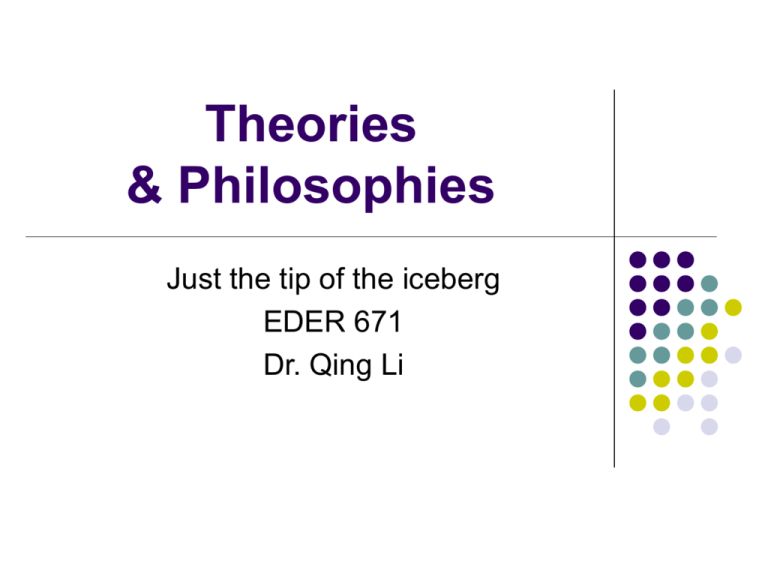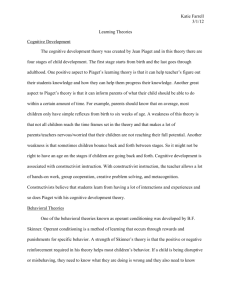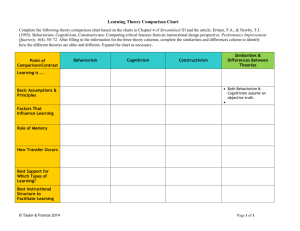Theories and Philosophies
advertisement

Theories & Philosophies Just the tip of the iceberg EDER 671 Dr. Qing Li Learning Theories What is a theory? A theory provides a general explanation for observations made over time, Explains and predicts behavior, Can never be established beyond all doubt May be modified Seldom has to be thrown out completely if thoroughly tested but sometimes a theory may be widely accepted for a long time and later disproved. (Dorin, Demmin & Gabel, 1990) 2 Brief overview of some learning theories based on OCSLD (2002) There are many different theories of learning. It is useful to consider their application to how your students learn and how you teach. It is important to think how you learn and realize that everyone does not learn the way you do. 3 Sensory Stimulation theory Its premise is that effective learning occurs when the senses are stimulated. 75% knowledge held by adults is learned through seeing, 13% through hearing. Other senses- touch, smell & taste account for 12%. By stimulating the senses, particularly the visual sense, learning can be enhanced. If multi-senses are stimulated, greater learning takes place. How: through greater variety of colors, volume levels, strong statements, facts presented visually, use of variety of techniques and media. 4 Reinforcement Theory Skinner: positive reinforcement, negative reinforcement, punishment. (details later) Note: much ‘competency based training’ is based on this theory. Very useful in learning repetitive tasks, but higher order learning is not involved. Criticism – too rigid and mechanical. 5 Holistic learning theory Premise: the individual personality consists of many elements… specifically… the intellect, emotions, the body impulse (or desire), intuition and imagination that all require activation if learning is to be more effective 6 Facilitation theory (the humanist approach) Carl Rogers, Premise: learning will occur by the educator acting as a facilitator, by establishing an atmosphere in which learners feel comfortable to consider new ideas and are not threatened by external factors. Believe that human beings have a natural eagerness to learn; There is some resistance to, and unpleasant consequences of, giving up what is currently held to be true; The most significant learning involves changing one’s concept of oneself. 7 Facilitation theory (2) Teachers are: Less protective of their constructs and beliefs than other teachers, More able to listen to learners, especially to their feelings, pay as much attention to their relationship with learners as to the content of the course Apt to accept feedback, both positive and negative and to use it as constructive insight into themselves and their behavior. 8 Facilitation theory (3) Learners Are encouraged to take responsibility for their own learning Provide much of the input for the learning which occurs through their insights and experiences Are encouraged to consider that the most valuable evaluation is self-evaluation and that learning needs to focus on factors that contribute to solving significant problems or achieving significant results. 9 Experiential learning Kolb’s 4-stage learning process •The process can begin at any of the stages and is continuous (no limit to the # of cycles). •Without reflection we would simply continue to repeat our mistakes. Have an experience Plan next steps, experimenting to find solution Review that experience Conclude from that experience 10 Experiential learning (2) Learning is through 1) concrete experience,2) observation & reflection, 3) abstract conceptualization, 4) active experimentation. People begin with their preferred style in the experiential learning cycle. Hence 4 learning styles: activist (prefer to learn by doing), reflector ( like to observe & reflect), theorist (like to have everything organized into a neat schema ASAP), pragmatist (enjoys the planning stage and keen to test things out in practice) Don’t know your learning style? http://www.stepchange.org.uk/Learning_Style_Ques tion.pdf 11 Action Learning Links the world of learning with the world of action through a reflective process within collaborative learning groups- “action learning sets”. The “sets” meet regularly to work on individuals’ real life issues with the aim of learning with and from each other. 12 Adult Learning (Andragogy) Knowles: adult learning was special. adults: Bring wealth experience to the learning environment – should be used as a resource. expect to have a high degree of influence on what they are to be educated for, and how they are to be educated. Andragogy is: student-centered, experience-based, problem-oriented and collaborative very much in the spirit of the humanist approach to learning and education. 13 Why bother? Some reasons: Learning theories permeate to all dimensions of educational technology. E.g. depending on the learners and situations, we design our instructional events (environments, systems, software) which would affect student learning. In ID, the designer must understand the strengths and weaknesses of each learning theory to optimize their use in appropriate instructional design strategy. 14 Your reason? Can you think of at least one good reason for us to learn all these theories? Can you use examples from your previous experience to explain your reasons? 15 Objectivism vs. Constructivism Based on Wilson (1997) & Roblyer (2003) Current educational Goals and Methods: Two views Directed instruction: grounded primarily in behaviorism and the information-processing branch of cognitive learning theories (acquisition metaphor). Constructivist instruction evolved from other branches of thinking in cognitive learning theory (participation metaphor). 17 Philosophical foundations Objectivist: knowledge has a separate, real existence of its own outside the human mind. Learning happens when this knowledge is transmitted to people and they store it in their minds. Constructivist: humans construct all knowledge in their minds by participating in certain experiences; learning occurs when one constructs both mechanisms for learning and her own unique version of the knowledge, colored by background, experiences, and aptitudes. A tree was falling off in the middle of a forest in BC and no body was around. Since nobody heard, did the falling tree make a noise? 18 Methodological differences Directed Teacher: transmitter of knowledge; expert source; director of skill/concept development through structured experiences Student: receive information; demonstrate competence; all students learn same material Curriculum: based on skill and knowledge hierarchies; skills taught one after the other in set sequence. Constructivist Teacher: guide and facilitator as students construct their own knowledge; collaborative resource and assistant as students explore topics. Student: collaborate with other; develop competence; students may learn different material Curriculum: based on projects/problems, etc. that foster both higher and lower level skills concurrently. 19 More methodological differences Directed Learning goals: stated in terms of mastery learning and behavioral competence in a scope and sequence Activities: lecture, demonstration, discussions, drill practice, seatwork, testing Assessment: written tests and development of products matched to objectives; all tests and products match set criteria; same measures for all students. Constructivist Learning goals: stated in terms of growth and increased ability to work independently and collaboratively. Activities: group projects, hands-on exploration, authentic tasks, product development Assessment: alternative assessment including performance assessment, portfolios; quality measured by rubrics and checklists; measures may differ among students. 20 Theoretical Foundations: Directed Behavioral theories: concentrate on immediately observable, thus, behavioral, changes in performance (tests) as indicators of learning. Pavlov: ‘conditioned response’, behavior is largely controlled by involuntary physical responses to outside stimuli (e.g. dogs salivating at the sight of dog food). 21 Behaviorist (Skinner, ‘stimulus-response’ ) behavior is more controlled by the consequences of actions than by events preceding the action. A consequence is an outcome (stimulus) after the behavior influence future behaviors. (e.g. a child reasons she will get praise if she behaves well in school). Since internal learning processes cannot be seen directly, the focus is on cause-and –effect relationships that can be established by observation. Human behavior can be shaped by ‘contingencies of reinforcement”: positive reinforcement – increase in desired behavior from a stimulus (study hard- praise) Negative reinforcement -increase in desired behavior from avoiding or removing a stimulus (not finish assignment – detention). Punishment – decrease in undesirable behavior from undesirable consequences. (cheating– failure) 22 Theoretical Foundations: Directed (cont.) Information Processing Theories: behaviorisms focus only on external directly observable indicators of learning, information-processing theory (first and most influential of the cognitive-learning theories) try to visualize what is impossible to observe directly. Human brain has 3 kinds of memories: sensory registers--memory that receives all the information a person senses (1 second) Short-term (working) memory (5-20 seconds) Long-term memory (indefinitely). 23 Theoretical Foundations: Directed (cont.) Information-Processing Theory: Model of human memory system Lost Lost Input (through eyes, mouth, etc.) Sensory Register attention Working (short term) memory Rehearsal Long term memory Meaningful learning Organizing Elaborating Imagery May lost if not using regularly 24 More directed: Gagne’s Principles Build on behaviorism and information-processing theories, Gagne translated principles from learning theories into practical instructional strategies. Events of instruction (9): to arrange optimal ‘conditions of learning’. 1. Gaining attention 2. Informing the learner of the objective 3. Stimulating recall of prerequisite learning 4. Presenting new material 5. Providing learning guidance 6. Eliciting performance 7. Formative assessment 8. Summative assessment 9. Enhancing retention and recall 25 More Gagne Types of learning: he identified types of learning as behaviors students demonstrate after acquiring knowledge. They differ according to the conditions necessary to foster them. He showed how the Events of Instruction would be carried out slightly different from one type of learning to another: 1. Intellectual skills 2. 3. 4. 5. Problem solving Higher order rules Defined concepts Concrete concepts discriminations Cognitive strategies Verbal information Motor skills attitudes 26 One more Gagne Learning hierarchies: the development of ‘intellectual skills requires learning that amounts to a building process. Lower level skills provide a necessary foundation for higher level ones. E.g. to learn long division, students first have to learn all prerequisite skills including number recognition, addition and subtraction, etc. Gagne’s work has been widely used to develop systematic instructional design principles (major influence in business, industry, and military training). 27 Your task: Working in groups of 3, try to develop a metaphor with a graphic presentation that shows your understanding of major characteristics of theories and philosophies behind “directed instruction”. Prepare a 2 min. presentation. 28 Constructivism The differences among those who think of themselves as constructivists makes it difficult to settle on a single definition. Theorists like Dewey, Vygotsky, Piaget, and Bruner are credited with fundamental premises of constructivism. 29 Social constructivism Dewey: curriculum should arise from student interests Curriculum topics should be integrated, not isolated. Education is growth, rather than an end in itself. Learning occurs through its connection with life, rather than through participation in curriculum. Learning should be hands on and experience based, rather than abstract. 30 Social constructivism (cont.) Vygotsky: Cognitive development is directly related to and based on social development. Zone of proximal development: difference between two levels of cognitive functioning (adult/expert and child/novice). Scaffolding: the assistance that an expert gives a novice to help him/her reach higher than would be possible by the novice’s efforts alone. 31 Piaget: Cognitive development Child’s 4 stages of cognitive development: 1. 2. 3. 4. Sensorimoter (birth-2 yrs.) –explore world through senses and motor activity. Cannot differentiate between self and environment (if they cannot see, it doesn’t exist) Preoperational: (2-7) – develop greater abilities to communicate via speech and to engage in symbolic activities (drawing object, play pretending and imaging). Concrete operational (7-11) – increase in abstract reasoning ability and ability to generalize. Formal operations (12-15) – can form and test hypotheses, organize information, reason scientifically, show results of abstract thinking in the form of symbolic materials. 32 Piaget (cont.) Piaget’s basic assumptions: 1. Children are active and motivated learners 2. Children’s knowledge of the world becomes more integrated and organized over time 3. Children learn through the processes of assimilation and accommodation 4. Cognitive development depends on interaction with one’s physical and social environment 5. The processes of equilibration (resolving disequilibrium) help to develop increasingly complex levels of thought 6. Cognitive development can occur only after certain genetically controlled neurological changes occur. 7. Cognitive development occurs in four qualitatively different stages. 33 Bruner: Learning as discovery Bruner also categorized children’s cognitive development stage: Enactive stage (0-3) Iconic stage (3-8) Symbolic stage (8-) Discovery learning: an approach to instruction through which students interact with their environment – by exploring and manipulating objects, wrestling with questions and controversies, or performing experiments. However, teachers found that discovery learning is most successful when student have prerequisite knowledge and undergo some structured experiences. 34 Gardner: Multiple intelligences Of all theories embraced by constructivists, Gardner is the only one that attempt to define the role of intelligence in learning. Types of intelligence: Linguistic; Musical; Logical-mathematical; Spatial; Bodily-kinesthetic; Intrapersonal; Interpersonal; Naturalist. Educational implication: teachers need to try to determine which types of intelligence each student has and direct the student to learning activities that capitalize on these innate abilities. 35 Constructivism (claims) Constructivism is more a philosophy (i.e. way of seeing the world), not a set of strategies. 1. The nature of reality– mental representations have ‘real’ ontological status just as the “world out there” does. Or, reality is more in the mind of the knower, the knower constructs (interprets) a reality based upon his/her apperceptions. The nature of knowledge – it is individually constructed; it’s inside people’s minds, not “out there”. 36 Constructivism (cont.) Human interaction– we rely on shared or “negotiated” meanings, better thought of as cooperative than authoritative or manipulative in nature. The nature of science-it is a meaning making activity with the biases and filters accompanying any human activity. 37 Philosophy or Rules? If we see the world in constructivist terms, we go about our jobs in a different way. But this difference cannot be reduced to a discrete set of rules or techniques. Too often, constructivism is equated with low structure and permissiveness-imposing predefined learning goals or a learning method is somehow interfering with students’ construction of meaning. This maybe true in extreme cases. 38 One example Scott, a teacher, who holds definitely constructivistic and anti-authoritarian philosophy wrote in journal: “Third hour composition I went to a seating chart, the first time I’ve done that here. I caught them as they came in and told them where to sit. Great improvement! Everyone working hard on their papers…I sense that students are relieved that I’ve imposed more structure”. Imposing a seating chart is a clear act of asserting authoritative control and imposing structure. Is Scott betraying his principles, or can an ostensibly “objectivist” instructional technique actually serve his constructivist learning and teaching goals? The students’ answer clearly indicate that they view it as supporting their own learning goals. 39 Creativity vs. Discipline Yet to help students become creative, some kind of discipline and structure must be provided. “Creativity arises out of the tension between spontaneity and limitations, the latter (like river banks) forcing the spontaneity into the various forms which are essential to the work of art… The significance of limits in art is seen most clearly when we consider the question of form. Form provides the essential boundaries and structure for the creative act” (Laurel, 1991, p.101). The point is that a given instructional strategy takes on meaning as it is used, in a particular context. 40 Holistic way of observing Hence, instructional strategies that impose structures may actually help students’ knowledge construction. One instructional strategy cannot tell whether it hinders or serves constructivist learning goals, rather the entire situation needs to be examined to make the judgments. 41 Constructivism (more claims) 2. You do not have to be a philosopher to take a position. 3. Basically, nobody admits to be an objectivism. Objectivism is primarily a pejorative label given by constructivists to the offending others. Realists (other name) believe there is a “reality” exists, and the quality of mental representations can be judged by their correspondence to the reality (another hotly debated issue). 42 What is your take on? There are many different interpretations of constructivism. An example: a Florida politician's position on a county option to permit the sale of liquor: “if by whiskey, you mean the water of life that cheers men’s souls, that smoothes out the tensions of the day, that gives gentle perspective to one’s view of life, then put my name on the list of the fervent wets. If by whiskey, you mean the devil’s brew that rends families, destroys careers and ruins one’s ability to work, then count me in the ranks of the dries.” 43 Constructivism (still more claims…would it end? :) Neither side is right. Mind is not a box that inside the box are reflections of what lies outside. The starting point is recognizing that we simply are in the world, working, acting and doing things. Hence individual cognition is dethroned as the center of the universe and placed back into the context of being par of the world. 44 Debate Prepare a debate on the benefits of using directed vs. constructivist models for teaching and learning. Each group should gather evidence to support arguments on one of the following aspects of one of the models: real, practice problems they address; the soundness of their underlying theories; the usefulness in preparing students for future education and work. (6 groups total). Conduct the debate in class. 45 Bibliography Dorin, H., Demmin, P., Gabel, D. (1990). Chemistry: The study of matter. (3rd ed.). Englewood Cliffs, NJ: Prentice Hall, Inc. OCSLD: The oxford centre for Staff and Learning Development. http://www.brookes.ac.uk/services/ocsd/2_learntch/theories.html [09/18/2003] Roblyer, M., & Edwards, J. (2000). Integrating educational technology into teaching (2 ed.). New Jersey: Prentice-Hall. Wilson, B. (1997). Reflections on constructivism and instructional design. In C. Dills & A. Romiszowski (Eds.), Instructional development paradigms. Englewood Cliffs, NJ: Educational Technology Publish. http://carbon.cudenver.edu/~bwilson/construct.html [09/18/2003] 46







